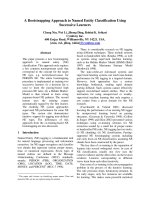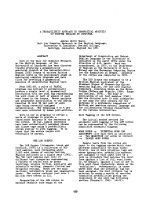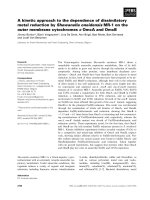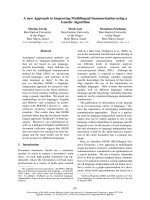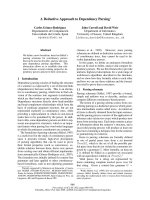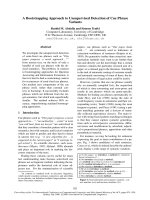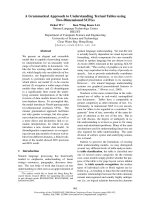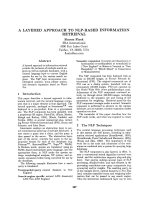Báo cáo khoa học: "A RULE-BASED APPROACH TO EVALUATING IMPORTANCE IN DESCRIPTIVE TEXTS" pptx
Bạn đang xem bản rút gọn của tài liệu. Xem và tải ngay bản đầy đủ của tài liệu tại đây (524.99 KB, 7 trang )
A RULE-BASED APPROACH TO EVALUATING IMPORTANCE IN DESCRIPTIVE TEXTS
Danilo Fum(*), Giovanni Gulda(?), Carlo Tasso(~)
Isllmm di Matemadca, Informatica
•
Slstemistica
Universi~ di Udlne
Udlne, Italy
ABSTRACT
Importance evaluation is one of the most
challenging problems in the field of text
processing. In the paper we focus on the notion of
importance from a computational standpoint, and we
propose a procedural, rule-based approach to
importance evaluation. This novel approach is
supported by a prototype experimental system,
called importance evaluator, that can deal with
descriptive texts taken from computer science
literature on operating systems. The evaluator
relies on a set of importance rules that are used
to assign importance values to the different parts
of a text and to resolve or explain conflicting
evaluations. The system utilizes world knowledge
on the subject domain contained in an encyclopedia
and takes into account a goal assigned by the user
for specifying the pragmatic aspects of the
understanding activity. The paper describes the
role of the evaluator in the frame of a larger
system for text summarization (SUSY); it
illustrates its overall mode of operation, and
discusses some meaningful examples.
I. INTRODUCTION
Text understanding has received increasing
attention in recent years. A major problem in this
area is that of importance evaluation: not all the
components of a sufficiently large and structured
piece of text are equally important for the reader,
and humans are able to evaluate the relative
importance of the parts of the texts they read.
This issue has been faced so far only in an
indirect way in the literature on discourse
structure (Kintsch and van Dijk, 1978; van Dijk
and Kintsch, 1983), summarization (Lehrert, 1982
and 1984; Wilensky, 1982; Hahn and Reimer, 1984),
and inference (Schank, 1979).
Moreover, several studies in the field of
summarization (e.g.: Schank, 1979 and 1982;
Lehnert, 1982 and 1984; Wilensky, 1982) have
mostly been concerned with narrative texts
(stories), and it is not at all obvious that the
approaches which proved successful in this area
(') also with: Laboratorio di Psicologia E.E.,
Universita' di Trieste, Trieste, Italy
(t) also with: Milan Polytechnic Artificial
Intelligence Project, Milano, Italy
(~) also with: CISM International Center for
Mechanical Sciences, Udine, Italy
could be applied to descriptive texts as well.
Expository prose has its own specific features
(Graesser, 1981), and it seems to require different
understanding processes, different summarization
skills, and different cognitive models (Lehnert,
1984). Work on the problem of understanding and
summarizing expository prose is still at the very
beginning (Hahn and Reimer, 1984).
In this paper we focus on the notion of
importance from a computational standpoint, and we
propose a rule-based approach to importance
evaluation. This research is part of a larger
project aimed at developi ng a system for
understanding and summarizing descriptive texts
(SUSY, a SUmmarizing SYstem), which is in progress
a~-~Te University" of
SUSY proposes an approach to descriptive text
understanding and summarization (Fum, Guida, and
Tasso, 1982, 1983, and 1984) in which the process
of representing the meaning of a natural language
text is split into three main tasks, namely:
sentence understanding, structure capturing, and
i mportance eval uati on.
The sentence understandin 9 phase works on the
single s~ that constitute a given natural
language text and maps them into a formal internal
representation, called basic linear representation
(BLR). The BLR is essentially a propositional
language appropriately extended and completed to
deal with the most relevant features of text
representation, and fully worked out in a way
suitable for computer implementation (Fum, Guida,
and Tasso, 1984). The BLR representation of a text
i s consti tuted by a sequence of I abel ed
propositions, each of them constituted by a
predicate with instantiated arguments or
representing an ISA relation between concepts.
This phase includes the understanding of the
literal meaning of each sentence in the text, the
appropriate representation of time relations, and
the treatment of quantification and reference.
The structure capturing phase works on the BLR
and produces an augmented version of it, called
extended linear representation (ELR). This phase
on two maln points:
- inferring and expliciting the
macro-structure of the text (van Dijk,
1977; Kintsch and van Dijk, 1978; van
Dijk and Kintsch, 1983), that accounts for
the conceptual connection (coherence)
among sentences (Hobbs, 1982 and 1983);
244
recognizing and expliciting the rhetoric
structure of the text, which explains how
the flow of ideas and the arguments of the
writer are organized and implemented in
the text.
The importance evaluation phase operates on
the ELR and attaches appropriate markers to its
components in order to produce a new
representation, called hierarchical propositional
network (HPN). The HPN is a tree-like structure
whose n~s, corresponding to concepts and
propositions of the ELR, are assigned different
importance values (integers) according to their
relative importance in the text.
Once the HPN representation of a text has been
produced, it is easy to prune the less relevant
parts in order to obtain the representation of an
appropriate summary to be eventually translated
into natural language. These last phases (i.e.,
pruning and generation) are, for the moment,
outside the scope of this research.
The purpose of this paper is to investigate in
some detail the phase of importance evaluation, and
to illustrate the results obtained in the design
and experimentation of a prototype system that can
produce from the ELR of a given text a reasonable
HPN.
The paper is organized as follows: section two
introduces the topic of importance evaluation and
discusses some basic conceptual aspects, in section
three the overall organization of the system is
presented with particular attention to knowledge
representation, section four illustrates some
examples of importance evaluation, and section five
concludes the paper.
2. EVALUATING IMPORTANCE
The topic of importance evaluation has been
dealt with in recent years, although often only in
a quite indirect way, by several authors and in
many different contexts. A part of a text can be
considered important in relation to other segments
of the same text according to several criteria:
it embodies knowledge necessary to
understand other parts of the text (van
Dijk, 1977; Kintsch and van Dijk, 1978);
- it is relevant to the topic of discourse
(Lehnert 1982 and 1984);
it is useful to clarify the relations that
make discourse coherent (Hobbs, 1982);
it relates to the topic-focus articulation
(Haji~ova' and Sgall, 1984);
it refers to objects or relations in the
subject domain that are judged to be
important a-priori (Schank, 1979);
-
it is unusual, new, or abnormal in the
subject domain (Schank, 1979);
it generates surprise (van Dijk and
Kintsch, 1983);
it is relevant to some specific reader's
goal or need (Fum, Guida, and Tasso,
1982).
In practice, if we test these criteria on
sample texts, they result sometimes complementary,
sometimes partially overlapping, sometimes even
conflicting. Moreover, different readers may judge
differently the importance of the same text; on
some parts a general consensus may be achieved, but
the evaluation of other parts may be definitely
subjective.
In fact, "important" means "specially relevant to
some goal", and, whenever the goal with which a
text is read changes, the parts of text which are
to be considered important vary accordingly. Even
if the goal of reading is only seldom considered
explicitly by humans, still some goal is always
implicitly assumed. Different readers (or the same
reader in different moments) may have different
goals, and conflicting judgments of importance may
be due to the consideration of different goals,
rather than to the application of different
evaluation procedures.
The above investigation shows that importance
is a really multifaceted concept which escapes a
simple, explicit, algorithmic definition. A
procedural, knowledge-based approach comprising a
set of rules that can assign relative importance
values to the different parts of a text and can
resolve or explain conflicting evaluations seems
more appropriate. Such an approach allows taking
into account in a flexible and natural way the
variety of knowledge sources and processing
activities that are involved in importance
evaluation. Moreover, it is expected to be well
founded from a cognitive point of view (van Dijk
and Kintsch, 1983; Anderson, 1976), as it allows
close and transparent modeling of several processes
that occur in human mind.
3. A COMPUTATIONAL APPROACH
Most of the ideas outlined in the previous
section have been implemented in the design of a
subsystem of SUSY, called the importance evaluator,
that takes in input the ELR representation of a
natural language text and the representation of a
reader's goal and produces in output the
corresponding HPN. The evaluator is implemented by
a rule-based system (Davis and King, 1976) with a
forward chaining control regime. Knowledge
available to the evaluator comprises two parts: a
rule base and an encyclopedia.
The rule base embodies expert knowledge
necessary ~r importance evaluation. It is
constituted by production rules, called importance
rules, having the usual IF-THEN form. Rules can be
245
classified according to their competence, i.e. to
the different types of knowledge utilized for
evaluating importance. From this point of view,
three classes of rules are considered:
structural rules, which express the fact
that some parts of the text can be judged
important just by looking at their
structure and organization, discarding
thei r meaning;
semantic ~ules, which can evaluate
importance by specifically taking into
account some specific structural features
of the text that convey a definite
meaning;
encyclopedic rules, which can evaluate
importance by comparing the meaning of the
text with domain specific knowledge
contained in the encyclopedia.
The IF-part of the rules contains conditions that
are evaluated with respect to the current HPN
(initially the ELR), and the THEN-part specifies
either an importance evaluation or an action to be
performed to further the analysis (e.g., a
strategic choice, a criterion to solve conflicting
evaluations, etc.).
The evaluation of importance contained in the
THEN-part of a rule takes usually the form of an
ordering relation (e.g., less, equal, etc.) among
importance values of concepts or propositions of
the ELR, or it specifies ranges of importance
values (e.g., high, low, etc.). Thus, rules only
assert relative importance of different parts of
the text: a constraint propagation algorithm will
eventually transform these relative evaluations
into absolute importance values according to a
given scale.
The encyclopedia is the second knowledge
source employed by the evaluator and it contains
domain specific knowledge. Encyclopedic knowledge
is represented through a net of frames. Frames
embody, in addition to a header, two kinds of
slots:
knowledge slots, that contain domain
specific knowledge, represented in a form
homogeneous with the propositional
language of the ELR;
reference slots, containing pointers to
other frames that deal with related topics
in the subject domain.
This organization allows easy implementation of a
property inheritance mechanism.
We now illustrate the notion of goal which is
of crucial importance for understanding the overall
mode of operation of the evaluator. The goal is a
chunk of variable knowledge, assigned by the user
taking into account the pragmatic aspects of the
understanding activity, that defines the
motivations and objectives that are behind the
reading process. The role of the goal is twofold:
exerting control on the activation of
importance rules that operate on the ELR;
selective focusing, i.e. enabling the
evaluator to choose from the encyclopedia
the pieces of knowledge which are expected
to be relevant to the current importance
evaluation.
The use of the goal in selective focusing comprises
two activities:
validating matching between the current
ELR and the knowledge contained in a frame
header or knowledge slot (direct frame
activation), or
activating a new frame pointed at in a
reference slot of a currently active frame
(i ndi rect frame acti vati on ).
Therefore, the encyclopedia does not contain any
a-priory judgment about importance. Full
responsibility of this activity is left to the
evaluator, which can interpret the content of the
encyclopedia frames according to the current goal
and can use the extracted knowledge to support the
rule-based evaluation process.
4. SAMPLE OPERATION OF THE EVALUATOR
The current prototype version of the evaluator
operates on simple texts taken from scientific and
technical computer science literature on operating
systems. It includes about 40 importance rules and
a small encyclopedia of about 30 frames. The goal
has been assigned a very simple structure: it is a
logical con~)ination of key-terms, chosen in a
predefinite set, that represent possible points of
view a reader can take in analyzing a text.
In this section we will illustrate some of the
most basic mechanisms of importance evaluation
through a few examples.
Let us consider the following sample text:
"U-DOS is an operating system developed by
Softproducts Ltd. in 1982. It has a modular
organization and is suitable for real-time
applications. U-DOS includes powerful tools for
interactive processing and supports a sophisticated
window management that makes it user friendly, i.e.
easily usable by novices or untrained end-users,
Easy operation is, in fact, the main reason of it
widespread diffusion in the data processing market,
especially among CAD/CAM users who appreciate its
graphic utilities."
The ELR of this text results (for
description of the formalism refer to:
and Tasso, 1984):
a com~olete
Fum, Guida,
010 *OP-SYSTEM (U-DOS)
020 DEVELOP (SOFTPRODUCTS-LTD, U-DOS, T1)
246
030 *PAST (T1)
040 *YEAR-1982 (T1)
045 TIME-SPEC (40,20)
050 HAVE (U-DOS, V1, P)
060 *ORGANIZATION (VI)
070 MODULAR (V1, P)
075 QUAL (70, 60)
080 SUIT (U-DOS, VV2, P)
090 *APPLICATION (VV2)
100 REAL-TIME (VV2, P)
105 QUAL (100, 90)
110 INCLUDE (U-DOS, VV3, P)
120 *TOOL (VV3)
130 POWERFUL (VV3, P)
135 QUAL (130, 120)
140 APPROPRIATE-TO (VV3, V4, P)
145 QUAL (140, 120)
150 *PROCESSING (V4)
160 INTERACTIVE (V4, P)
165 QUAL (160, 150)
170 SUPPORT (U-DOS, V5, P)
180 *WINDOW-MANAGEMENT (V5)
190 SOPHISTICATED (VS, P)
195 QUAL (190, 180)
200 MAKE (VS, U-DOS, 210, P)
205 ENABLE (190, 210)
210 USER-FRIENDLY (U-DOS, P)
215 CLARIFICATION (220, 210)
220 OR (230, 260, P)
230 EASILY (240, P)
240 USE (VV6, U-DOS, P)
245 MOD (230, 240)
250 *NOVICE (VV6)
260 EASILY (270, P)
270 USE (VV7, U-DOS, P)
275 MOD (260, 270)
280 *END-USER (VV7)
290 UNTRAINED (VV7, P)
295 QUAL (290, 280)
300 REASON-FOR (310, 340)
305 RESULT (310, 340)
310 EASILY (320, P)
320 OPERATE (NIL, U-DOS)
325 MOD (310, 320)
330 HAVE (U-DOS, V8, P)
340 *DIFFUSION (V8)
350 LARGE (VS, P)
355 QUAL (350, 340)
360 IN (330, vg, P)
370 *DATA-PROCESSING-MARKET (V9)
380 AMONG (330, VVIO, P)
385 SPECIFICATION (360, 380)
390 *CAD/CAM-USER (VVlO)
400 APPRECIATE (VVlO, VV11, P)
410 *UTILITY (VV11)
420 GRAPHIC (VV11, P)
425 QUAL (420, 410)
430 HAVE (U-DOS, VV11, P)
The set of key-terms that can be used to
specify the goal includes, among others: KNOW,
BUY, and USE. We assume hereinafter the goal KNOW,
i.e., we are particularly interested in knowing the
main technical features of the U-DOS operating
system. With such a goal, some pieces of the
encyclopedia turn out to be relevant to the
evaluation of our sample text, while others are
discarded, as it will be illustrated below.
In order to analyze the text, the evaluator
generates from the ELR, as a preliminary step, a
new structure, called the cohesion graph, that
explicitly shows all the references among
propositions of the ELR. The cohesion graph is a
bipartite graph whose nodes are constituted by
concepts and propositions connected by three kinds
of arcs:
directed arcs connecting pairs of
propositions (say from P to Q), which
represent embedding of a proposition into
another (Q in P);
simple arcs, connecting a concept and a
proposition, which indicate that the
concept appears as an argument in the
proposition;
double directed arcs, connecting two
concepts via a propositional node (say
from A to B via P), which show that a
concept enters as the argument of a
proposition stating an ISA relation (P
states that A ISA B).
A portion of the cohesion graph of our sample text
is shown in Figure 1.
Structural rules can exploit the information
provided by the cohesion graph in order to
selectively capturing the importance of the
different parts of the text. An example of a
structural rule is:
Rule $4: Highly Referenced Concept
IF in the cohesion graph there is a concept C
which is at least K-referenced
THEN assign C an importance value w(C) = high.
This rule guesses that a concept which is
highly referenced in a text is probably important.
In our example (where the parameter K is set equal
to 3), the concept U-DOS is considered important as
it is highly referenced.
Importance can be evaluated by chaining
several rules. As an example, after rule $4 has
been applied, the following rule can fire:
Rule MT: ISA Proposition
IF a proposition P represents an ISA relation
AND
the argument of P is a concept C with
importance value w(C)
THEN assign P an importance value w(P) = w(C).
The rationale of this rule is that, if a
concept is important, any proposition that states
an ISA relation about that concept is important
too. This allows, for example, considering
proposition 10 (which states that U-DOS is an
operating system) as important.
Rule M7 allows, moreover, the application
247
J SOFTPRODUCTS -
LTO
IORGANIZATIONI I
J YEAR-1982 I
APPLICATION
(
F
U-DOS
OP-SYSTEM J
~ PROCESSING I
WINDOW-MANAGEMENT I
Fig. I: (Partial) Cohesion Graph of the Sample Text
of the following rule:
Rule E6: ISA Frame Activation
IF a proposition P represents an ISA relation
AND
P has importance value w(P) > low
AND
the predicate of P is the header of a frame
F in the encyclopedia
THEN activate F.
In our example, the fact that proposition 10
is important (w(P) = high) and that it represents
an ISA relation allows the OPERATING-SYSTEM frame
to be activated (see Figure 2, where a portion of
the encyclopedia relevant to the current example is
shown). Note that rule E6 does not directly state
whether a proposition or a concept has to be
considered important or not, but it specifies which
frames are to be considered relevant in the current
context.
Most evaluations are goal dependent and rely
on a goal interpreter, able to evaluate a specific
piece of ELR or a frame slot of the encyclopedia in
order to determine its relevance to the current
goal. The goal interpreter performs in such a way
a complex matching, which allows implementation of
selective focusing. Consider, for example, the
following rule:
RULE E19: Goal-Dependent Frame Activation
IF the current goal matches a reference slot
• R of an active frame
THEN activate the frame whose header is pointed
at by R.
Successive applications of this rule allow
activation, starting from the OPERATING-SYSTEM
frame, of the SOFTWARE-SYSTEM frame and, then, of
the COMPLEX-SYSTEM frame (see Figure 2). At this
point the following rule applies:
248
OP-SYSTEM
isa : SOFTWARE-SYSTEM
PRODUCT
has parts : KERNEL
SCHEDULER
MEMORY ALLOCATOR
includes : OS/I
RTOS
XENIX
basic operating characteristics:
OP-SYSTEM (X) BATCH (X)
REAL-TIME (X)
MULTI-USER (X)
OP-SYSTEM (X) RUN-ON (X,Y)
COMPUTER (Y) FOR (X,Y)
/
SOFTWARE-SYSTEM
isa : COMPLEX-SYSTEM
PROGRAM
PROCEDURE
has parts : MODULE
ROUTINE
SUBSYSTEM
language :
lO SOFTWARE-SYSTEM (X)
20 LANGUAGE (Y)
OF (lO,20)
/
COMPLEX-SYSTEM
structure :
COMPLEX-SYSTEM
(X)
MODULAR (X)
EXTENSIBLE (X)
HIERARCHICAL (X)
Fig. 2: Some Frames of the Encyclopedia
Rule E25: Goal Dependent Matching
IF a proposition P matches a pattern contained
in a knowledge slot K of an active frame
AND
the current goal matches K
THEN assign P an importance value w(P) = high.
In our example, since (i) the COMPLEX-SYSTEM
frame is active and proposition 70 of the ELR
matches the pattern MODULAR (ORGANIZATION) of the
"structure" slot of the frame, and (ii) the goal
interpreter evaluates that the knowledge slot
"structure" is relevant to the goal KNOW, then
proposition 70 is considered important.
As a last example, we illustrate a rule that
exploits knowledge concerning the macro-structure
of the text:
Rule M9: Macro Clarification
IF if there exists a macro-proposition
CLARIFICATION (P, Q)
THEN assign P and Q importance values such that
w(P) < w(Q).
Rule M9 implements the idea that a proposition
which is used to clarify another proposition (i.e.,
it paraphrases its content or explains the meaning
of some of its terms) has to be considered less
important than the proposition it clarifies. This
rule can be applied, for example, in rating
propositions 210 and 220, the latter resulting less
important than the former.
5. CONCLUSION
The importance evaluator described in the
previous sections is written in Franz Lisp and it
is presently running in a prototype version on a
SUN-2 workstation. Much experimental work is
currently ongoing on this prototype in order to
assess its operation, enlarge its knowledge base,
and test its performance with a sufficiently large
set of sample texts.
The major contribution of the work reported in
the paper can be found in the novel proposed
approach to importance evaluation that, according
to the results so far achieved, proved to be viable
and appropriate both from the cognitive and the
computational points of view.
249
The research has disclosed several new
directions for future work. Among these we
mention:
extending the importance rule base to
cover the rhetoric and stylistic aspects
of the text;
introducing meta-rules to deal with the
problems of rule activation scheduling,
and of conflict resolution among rules;
improving the goal matching techniques in
order to implement a flexible mechanism
for interpreting the content of
encyclopedia frames according to the
current goal;
giving the evaluator the capability of
changing the goal during the evaluation
process, depending on the content of the
processed text.
REFERENCES
I.
2.
3.
4.
5.
6.
7.
Anderson J.R. (1976). Language, Memory,
and Thought, Hillsdale, NJ: Lawrence
~'-~au m.
Davis R. and King J. (1976). An
Overview of Production Systems. In
E.W.Elcock and D.Michie (Eds.), Machine
Intelligence 8, New York, NY: Wiley,
300-332.
Fum D., Guida G., and Tasso C. (1982).
Forward and Backward Reasoning in
Automatic Abstracting. In J. Horecky
(Ed.), COLING-82, Amsterdam, NL:
North-Holland, 83-88.
Fum D., Guida G., and Tasso C. (1983).
Capturing Importance in Natural Language
Texts: An HPN-Based Approach. Proc. 2nd
Int. Colloquium on the Interdisciplinary
~t-O~-y of the ~ma-'nt-ics of Natura~
Lan.~: Meaning and Lexicon, Kleve,
Fum O., Guida G., and Tasso C. (1984). A
Propositional Language for Text
Representation. In B.G. Bara and G.
Guida (Eds.), Computational Models of
Natural Language Processing, ms~-m-s~-rda~,
l~-~ ~'ortIT~IToTT~'nd, 121-163,
Graesser A.C. (1981). Prose
Comprehension Beyond the Word. New York,
NY: Springer-Verlag.
Haji~ova' E. and Sgall P. (1984). From
Topic and Focus of a Sentence to Linking
in a Text. In B.G. Bara and G. Guida
(Eds.), Computational Models of Natural
Language Processing, Amsterdam, NL:
North-Holland, 151-163.
8. Hahn U. and Reimer U. (1984). Computing
Text Constituency: An Algorithmic
Approach to the Generation of Text Graphs.
In C.J. van Rijsbergen (Ed.), Research
and Development in Information Retrieval,
]~'a,~) rid ge, UK: Can~)ridge University
Press, 343-368.
9. Hobbs J.R. (1982). Towards an
Understanding of Coherence in Discourse.
In W.G. L~hnert and M.H. Ringle (Eds.),
Strategies for Natural Language
Processing, Hi-Tl-sdal e~ Lawrence
Erl baum, ~23-244.
10. Kintsch W. and van Dijk T.A. (1978).
Toward a Model of Text Comprehension.
Psychological Review 85, 363-394.
11. Lehnert W.G. (1982). Plot Units: A
Narrative Summarization Strategy. In W.G.
Lehnert and M.H. Ringle (Eds.) ,
St rategi es for Natural Language
Processing, Hi-'~Tsd al e~ Lawrence
Erl baum, 375-414.
12. Lehnert W.G. (1984). Narrative
Complexity Based on Summari zati on
Algorithms. In B.G. Bara and G. Guida
(Eds.), Computational Models of Natural
Language Processing, Amsterdam,
North-Hol I and, 247-259.
13. Schank R.C. (1979). Interestingness:
Controlling Inferences. Artificial
Intelligence 12, 273-297.
14. Schank R.C. (1982). Reminding and Memory
Organization: An Introduction to MOPs.
In W.G. Lehnert and M.H. Ringle (Eds.),
Strateg!es for Natural Language
Process I ng, HTITsd al e~ Lawrence
Erl baum, 455-494.
15. van Dijk T.A. (1977). Semantic Macro
Structures and Knowledge Frames in
Discourse Comprehension. In M.A. Just
and P.A. Carpenter (Eds.), Cognitive
Processes in Comprehension, Hillsdale, NJ:
Lawrence Er-Tbaum, 3-32.
16. van Dijk T.A. and Kintsch W. (1983).
Strategies of Discourse Comprehension.
17.
New York, NY: Academic Press.
Wilensky R. (1982) Points: A Theory of
the Structure of Stories in Memory. In
W.G. Lehnert and M.H. Ringle (Eds.),
Strategies for Natural Language
Processing, H~sdale~ Lawrence
Erlbaum, 345-374.
250
